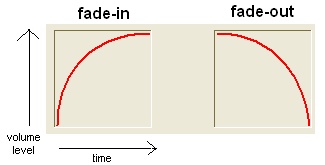Remarks
Adds a new volume point, based upon a custom volume curve, to the current volume automation procedure. The custom volume curve is characterized by the position of the two control points of the Bézier curve obtained through the usage of the custom curve designer.

For further information about the use of the embedded CurveDesigner refer to the tutorial How to create custom volume curves.
For further details about defining a volume automation procedure refer to the How to define a volume automation procedure section.
For further details about methods related to the use of special effects refer to the Effects COM object.
Syntax
[Visual Basic]
control.Effects.VolumeAutomationPointAddNewWithCustomCurve (
fPosition as Single,
fVolumeLevel as Single,
nLeftX as Integer,
nLeftY as Integer,
nRightX as Integer,
nRightY as Integer
) as enumErrorCodes
|
|
[C++]
short control.Effects.VolumeAutomationPointAddNewWithCustomCurve (
float fPosition,
float fVolumeLevel,
short nLeftX,
short nLeftY,
short nRightX,
short nRightY
);
|
|
Parameter
|
Description
|
|
|
fPosition
|
Position, expressed in the unit set through the Effects.VolumeAutomationSetScales method, where the volume point will be applied
|
fVolumeLevel
|
Volume applied starting from the current automation point: the value is expressed in the unit set through the Effects.VolumeAutomationSetScales method.
|
nLeftX
|
Horizontal position, expressed in percentage, of the left control point of the Bézier curve
|
nLeftY
|
Vertical position, expressed in percentage, of the left control point of the Bézier curve
|
nRightX
|
Horizontal position, expressed in percentage, of the right control point of the Bézier curve
|
nRightY
|
Vertical position, expressed in percentage, of the right control point of the Bézier curve
|
Return value
Value
|
Meaning
|
|
|
Negative value
|
An error occurred (see the LastError property for further error details)
|
enumErrorCodes.ERR_NOERROR (0)
|
The method call was successful.
|
|





